Assessment of Socio-Economic and Environmental Impacts of Energy Efficiency Improvements in Multi-Apartment Buildings: Case Study of Lithuania
Abstract
1. Introduction
2. Materials and Methods
2.1. The CleanProdLT Model
2.2. Scenarios
2.3. Assumptions
3. Results
3.1. Changes in Real GDP
3.2. Changes in Employment
3.3. Changes in Youth (Age 15–24) Employment
3.4. Changes in GHG Emissions
4. Discussion
5. Conclusions and Recommendations
Author Contributions
Funding
Institutional Review Board Statement
Informed Consent Statement
Data Availability Statement
Acknowledgments
Conflicts of Interest
References
- Liao, H.; Ren, R.; Li, L. Existing Building Renovation: A Review of Barriers to Economic and Environmental Benefits. Int. J. Environ. Res. Public Health 2023, 20, 4058. [Google Scholar] [CrossRef] [PubMed]
- Figus, G.; Turner, K.; McGregor, P.; Katris, A. Making the case for supporting broad energy efficiency programmes: Impacts on household incomes and other economic benefits. Energy Policy 2017, 111, 157–165. Available online: https://www.sciencedirect.com/science/article/pii/S0301421517305888 (accessed on 22 October 2024). [CrossRef]
- Celani de Macedo, A.; Alessandra, N.; Barbier, L.; Matteini, M.; Pasqualetto, G. The Impact of Industrial Energy Efficiency on Economic and Social Indicators. 2020. Available online: https://downloads.unido.org/ot/16/87/16879045/WP_2_2020_FINAL.pdf (accessed on 9 January 2025).
- Choi, J.-K.; Morrison, D.; Hallinan, K.P.; Brecha, R.J. Economic and environmental impacts of community-based residential building energy efficiency investment. Energy 2014, 78, 877–886. [Google Scholar] [CrossRef]
- Garrido-Soriano, N.; Rosas-Casals, M.; Ivancic, A.; Álvarez-del Castillo, M.D. Potential energy savings and economic impact of residential buildings under national and regional efficiency scenarios. A Catalan case study. Energy Build. 2012, 49, 119–125. [Google Scholar] [CrossRef]
- Bataille, C.; Melton, N. Energy efficiency and economic growth: A retrospective CGE analysis for Canada from 2002 to 2012. Energy Econ. 2017, 64, 118–130. [Google Scholar] [CrossRef]
- Ryan, L.; Campbell, N. Spreading the Net: The Multiple Benefits of Energy Efficiency Improvements; OECD: Paris, France, 2012. [Google Scholar]
- Figus, G.; Turner, K.; Katris, A. Energy-saving innovations and economy-wide rebound effects. In Transitions in Energy Efficiency and Demand; Routledge: Oxfordshire, UK, 2018; ISBN 978-1-351-12726-4. Available online: https://www.taylorfrancis.com/chapters/oa-edit/10.4324/9781351127264-9/energy-saving-innovations-economy-wide-rebound-effects-gioele-figus-karen-turner-antonios-katris (accessed on 19 December 2024).
- Thema, J.; Suerkemper, F.; Couder, J.; Mzavanadze, N.; Chatterjee, S.; Teubler, J.; Thomas, S.; Ürge-Vorsatz, D.; Hansen, M.B.; Bouzarovski, S.; et al. The Multiple Benefits of the 2030 EU Energy Efficiency Potential. Energies 2019, 12, 2798. [Google Scholar] [CrossRef]
- Fowlie, M.; Greenstone, M.; Wolfram, C. Do Energy Efficiency Investments Deliver? Evidence from the Weatherization Assistance Program. Q. J. Econ. 2018, 133, 1597–1644. [Google Scholar] [CrossRef]
- Fowlie, M.; Meeks, R. The Economics of Energy Efficiency in Developing Countries. Rev. Environ. Econ. Policy 2021, 15, 238–260. [Google Scholar] [CrossRef]
- Tenente, M.; Henriques, C.; Gomes, Á.; da Silva, P.P. Assessing energy, economic, environmental and social impacts of fostering energy efficiency technologies: A Portuguese case study. Environ. Dev. Sustain. 2024, 133, 1–24. [Google Scholar] [CrossRef]
- Schmidt, S.; Weigt, H. A Review on Energy Consumption from a Socio-Economic Perspective: Reduction Through Energy Efficiency and Beyond. 2013. Available online: https://papers.ssrn.com/sol3/papers.cfm?abstract_id=2376169 (accessed on 19 December 2024).
- European Commission. The European Green Deal—European Commission. Available online: https://commission.europa.eu/strategy-and-policy/priorities-2019-2024/european-green-deal_en (accessed on 7 June 2024).
- Chomać-Pierzecka, E.; Sobczak, A.; Urbańczyk, E. RES Market Development and Public Awareness of the Economic and Environmental Dimension of the Energy Transformation in Poland and Lithuania. Energies 2022, 15, 5461. [Google Scholar] [CrossRef]
- Prozuments, A.; Borodinecs, A.; Zaharovs, S.; Banionis, K.; Monstvilas, E.; Norvaišienė, R. Evaluating Reduction in Thermal Energy Consumption across Renovated Buildings in Latvia and Lithuania. Buildings 2023, 13, 1916. [Google Scholar] [CrossRef]
- Chandrasekaran, V.; Dvarioniene, J.; Vitkute, A.; Gecevicius, G. Environmental Impact Assessment of Renovated Multi-Apartment Building Using LCA Approach: Case Study from Lithuania. Sustainability 2021, 13, 1542. [Google Scholar] [CrossRef]
- Biekša, D.; Šiupšinskas, G.; Martinaitis, V.; Jaraminienė, E. Energy efficiency challenges in multi-apartment building renovation in Lithuania. J. Civ. Eng. Manag. 2011, 17, 467–475. [Google Scholar] [CrossRef]
- Streimikiene, D.; Balezentis, T. Willingness to Pay for Renovation of Multi-Flat Buildings and to Share the Costs of Renovation. Energies 2020, 13, 2721. [Google Scholar] [CrossRef]
- Štreimikienė, D.; Lekavičius, V.; Stankūnienė, G.; Pažėraitė, A. Renewable Energy Acceptance by Households: Evidence from Lithuania. Sustainability 2022, 14, 8370. [Google Scholar] [CrossRef]
- Lekavičius, V.; Bobinaitė, V.; Balsiūnaitė, R.; Kliaugaitė, D.; Rimkūnaitė, K.; Vasauskaitė, J. Socioeconomic impacts of sustainability practices in the production and use of carrier bags. Sustainability 2023, 15, 12060. [Google Scholar] [CrossRef]
- FIGARO—Integrated Global Accounts for Economic Modelling. Available online: https://ec.europa.eu/eurostat/web/products-eurostat-news/-/edn-20210526-1 (accessed on 12 December 2024).
- Eurostat. Non-Financial Transactions—Quarterly Data (nasq_10_nf_tr). Available online: https://ec.europa.eu/eurostat/cache/metadata/en/nasq_10_nf_tr_esms.htm (accessed on 25 November 2024).
- Lietuvos Respublikos Socialinės Apsaugos ir Darbo Ministerija. Užimtumo ir Nedarbo Rodikliai. Available online: https://socmin.lrv.lt/lt/veiklos-sritys/darbo-rinka-uzimtumas/uzimtumo-ir-darbo-rinkos-politika/uzimtumo-ir-nedarbo-rodikliai/ (accessed on 21 October 2024).
- Statista. EU Youth Unemployment 2024, by Country. Available online: https://www.statista.com/statistics/613670/youth-unemployment-rates-in-europe/ (accessed on 21 October 2024).
- Lekavičius, V.; Galinis, A.; Miškinis, V. Long-term economic impacts of energy development scenarios: The role of domestic electricity generation. Appl. Energy 2019, 253, 113527. [Google Scholar] [CrossRef]
- Lietuvos Respublikos Seimas. XII-2702 Lietuvos Respublikos Energijos Vartojimo Efektyvumo Didinimo Įstatymas. Available online: https://e-seimas.lrs.lt/portal/legalAct/lt/TAD/1bd85ba0a27b11e68987e8320e9a5185/asr (accessed on 21 October 2024).
- The Government of the Republic of Lithuania. 2050 Long-Term Strategy, Climate Action—European Commission. Available online: https://climate.ec.europa.eu/eu-action/climate-strategies-targets/2050-long-term-strategy_en (accessed on 17 February 2021).
- Lietuvos Respublikos aplinkos ministerija. D1-375 Dėl Daugiabučiams Namams Atnaujinti (Modernizuoti) Valstybės Paramos Teikimo ir Kvietimo Teikti p. Available online: https://e-seimas.lrs.lt/portal/legalAct/lt/TAD/fd035a9271b811ed8a47de53ff967b64/asr (accessed on 9 January 2025).
- Delfi.lt. Valstybė ir Renovacija—Kokia Parama Skiriama Gyventojams? Delfi Užsakomasis Turinys. Available online: https://www.delfi.lt/uzsakomasis-turinys/bustas/valstybe-ir-renovacija-kokia-parama-skiriama-gyventojams-90361805 (accessed on 9 January 2025).
- Bobinaite, V.; Balsiunaite, R.; Konstantinaviciute, I.; Lekavicius, V. Assessment of socioeconomic impacts of energy efficiency in multi-family buildings: Case of Lithuania. In Proceedings of the IAEE 45th International Conference Istanbul, Istanbul, Türkiye, 25–28 June 2024. [Google Scholar]
- Taki, A.; Zakharanka, A. The Impact of Degradation on a Building’s Energy Performance in Hot-Humid Climates. Sustainability 2023, 15, 1145. [Google Scholar] [CrossRef]
- Bae, M.; Ahn, H.; Kang, J.; Choi, G.; Choi, H. Determination of the Long-Term Thermal Performance of Foam Insulation Materials through Heat and Slicing Acceleration. Polymers 2022, 14, 4926. [Google Scholar] [CrossRef] [PubMed]
- Eleftheriadis, G.; Hamdy, M. The Impact of Insulation and HVAC Degradation on Overall Building Energy Performance: A Case Study. Buildings 2018, 8, 23. [Google Scholar] [CrossRef]
- Oficialios statistikos portalas. Rodiklių Duomenų Bazė—Oficialiosios Statistikos Portalas. Available online: https://osp.stat.gov.lt/lt/statistiniu-rodikliu-analize?hash=ce2b9fca-2faa-48fa-aa31-c83ff04b6c3b#/ (accessed on 9 January 2025).
- Daugiabučių namų modernizavimo fondas. Daugiabučių Namų Modernizavimo Fondas|ILTE. Available online: https://ilte.lt/paslaugos/25/daugiabuciu-namu-modernizavimo-fondas-149 (accessed on 21 October 2024).
- Lietuvos šilumos tiekėjų asociacija. CŠT Sektoriaus Apžvalga. Available online: https://lsta.lt/silumos-ukis/cst-sektoriaus-apzvalga/ (accessed on 16 December 2024).
- Bartolucci, B.; Frasca, F.; Flores-Colen, I.; Bertolin, C.; Siani, A.M. Key Performance Indicators: Their use in the energy efficiency retrofit for historic buildings. Procedia Struct. Integr. 2024, 55, 110–118. [Google Scholar] [CrossRef]
- Uddin, K.M.K.; Rahman, M.M.; Saha, S. The impact of green tax and energy efficiency on sustainability: Evidence from Bangladesh. Energy Rep. 2023, 10, 2306–2318. [Google Scholar] [CrossRef]
- Baatz, B. Everyone Benefits: Practices and Recommendations for Utility System Benefits of Energy Efficiency. Available online: https://www.aceee.org/sites/default/files/publications/researchreports/u1505.pdf (accessed on 16 December 2024).
- Mirasgedis, S.; Tourkolias, C.; Pavlakis, E.; Diakoulaki, D. A methodological framework for assessing the employment effects associated with energy efficiency interventions in buildings. Energy Build. 2014, 82, 275–286. [Google Scholar] [CrossRef]
- Pollitt, H.; Alexandri, E.; Anagnostopoulos, F.; Farhangi, C.; Hoste, T.; Markkanen, S.; Theillard, P.; Vergez, C.; Voogt, M. The Macro-Level and Sectoral Impacts of Energy Efficiency Policies. 2017. Available online: https://energy.ec.europa.eu/publications/macro-level-and-sectoral-impacts-energy-efficiency-policies_en (accessed on 19 December 2024).
- Li, T.; Yue, X.-G.; Waheed, H.; Yıldırım, B. Can energy efficiency and natural resources foster economic growth? Evidence from BRICS countries. Resour. Policy 2023, 83, 103643. [Google Scholar] [CrossRef]
- Popescu, D.; Bienert, S.; Schützenhofer, C.; Boazu, R. Impact of energy efficiency measures on the economic value of buildings. Appl. Energy 2012, 89, 454–463. [Google Scholar] [CrossRef]
- Phadkantha, R.; Tansuchat, R. Dynamic impacts of energy efficiency, economic growth, and renewable energy consumption on carbon emissions: Evidence from Markov Switching model. Energy Rep. 2023, 9, 332–336. [Google Scholar] [CrossRef]
- Liu, L.; Moshfegh, B.; Akander, J.; Cehlin, M. Comprehensive investigation on energy retrofits in eleven multi-family buildings in Sweden. Energy Build. 2014, 84, 704–715. [Google Scholar] [CrossRef]
- Oyewole, O.J.; Al-Faryan, M.A.S.; Adekoya, O.B.; Oliyide, J.A. Energy efficiency, financial inclusion, and socio-economic outcomes: Evidence across advanced, emerging, and developing countries. Energy 2024, 289, 130062. [Google Scholar] [CrossRef]
- Croucher, M. What is important when modeling the economic impact of energy efficiency standards? Util. Policy 2012, 22, 50–57. [Google Scholar] [CrossRef]
- Földváry, V.; Bekö, G.; Langer, S.; Arrhenius, K.; Petráš, D. Effect of energy renovation on indoor air quality in multifamily residential buildings in Slovakia. Build. Environ. 2017, 122, 363–372. [Google Scholar] [CrossRef]
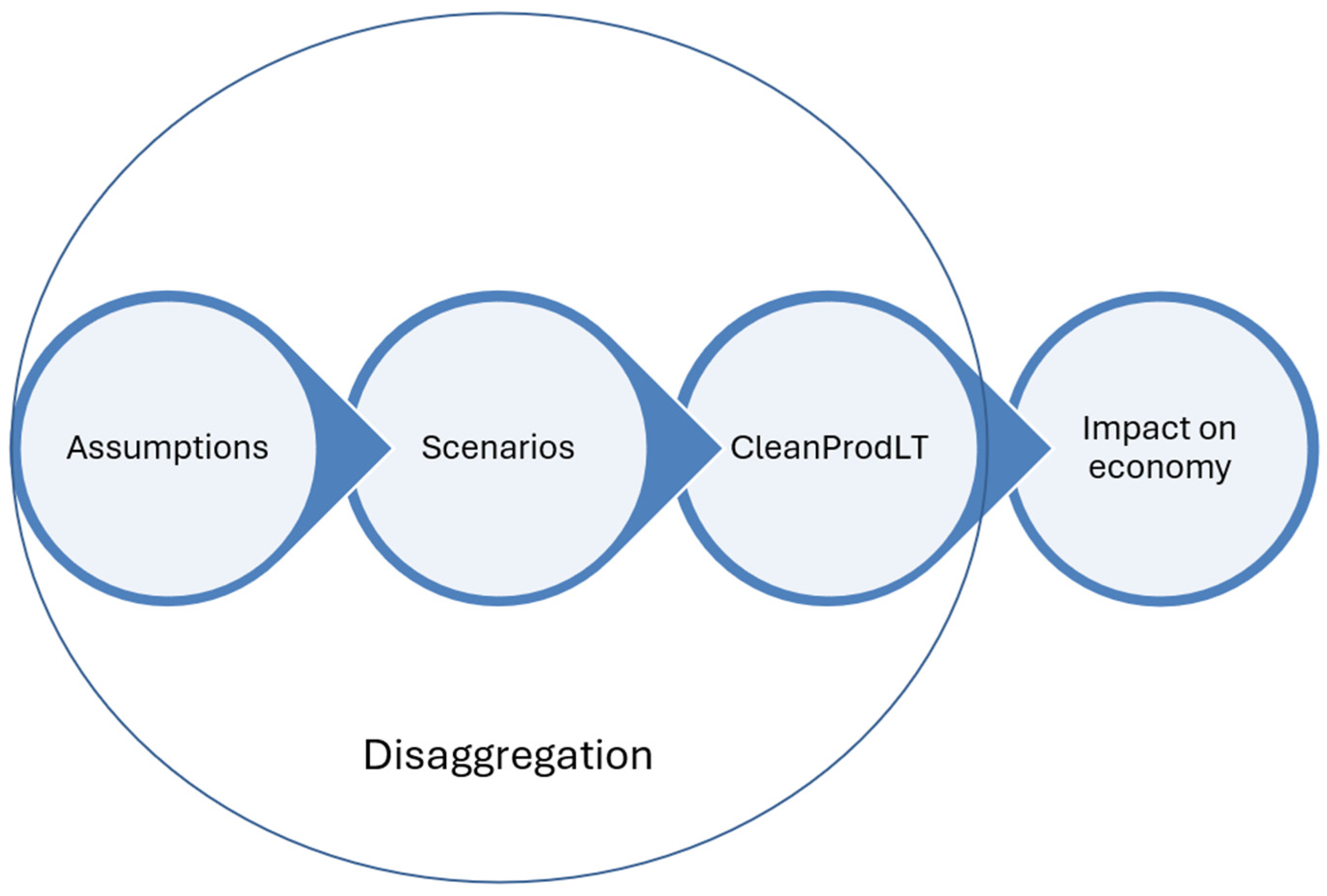
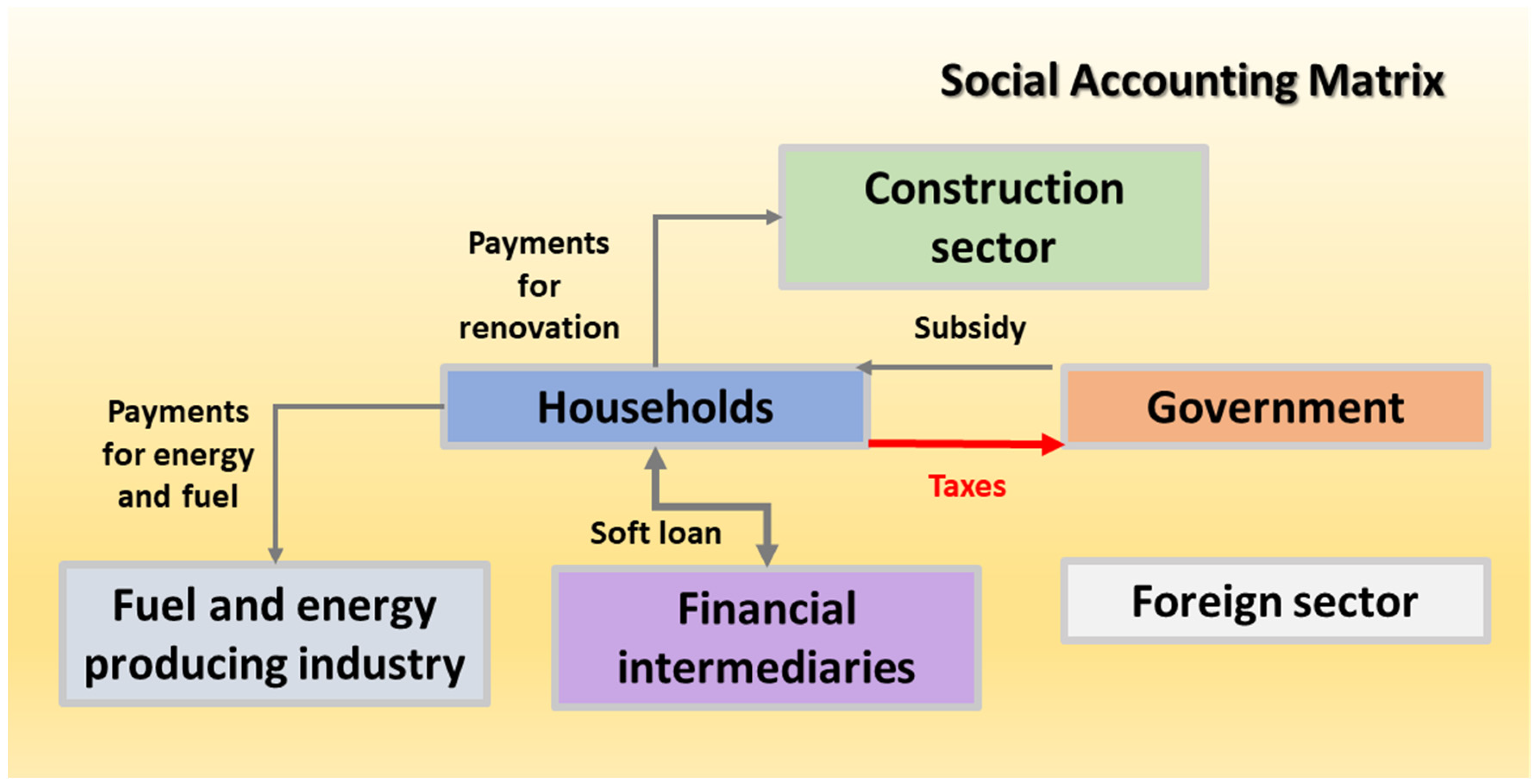
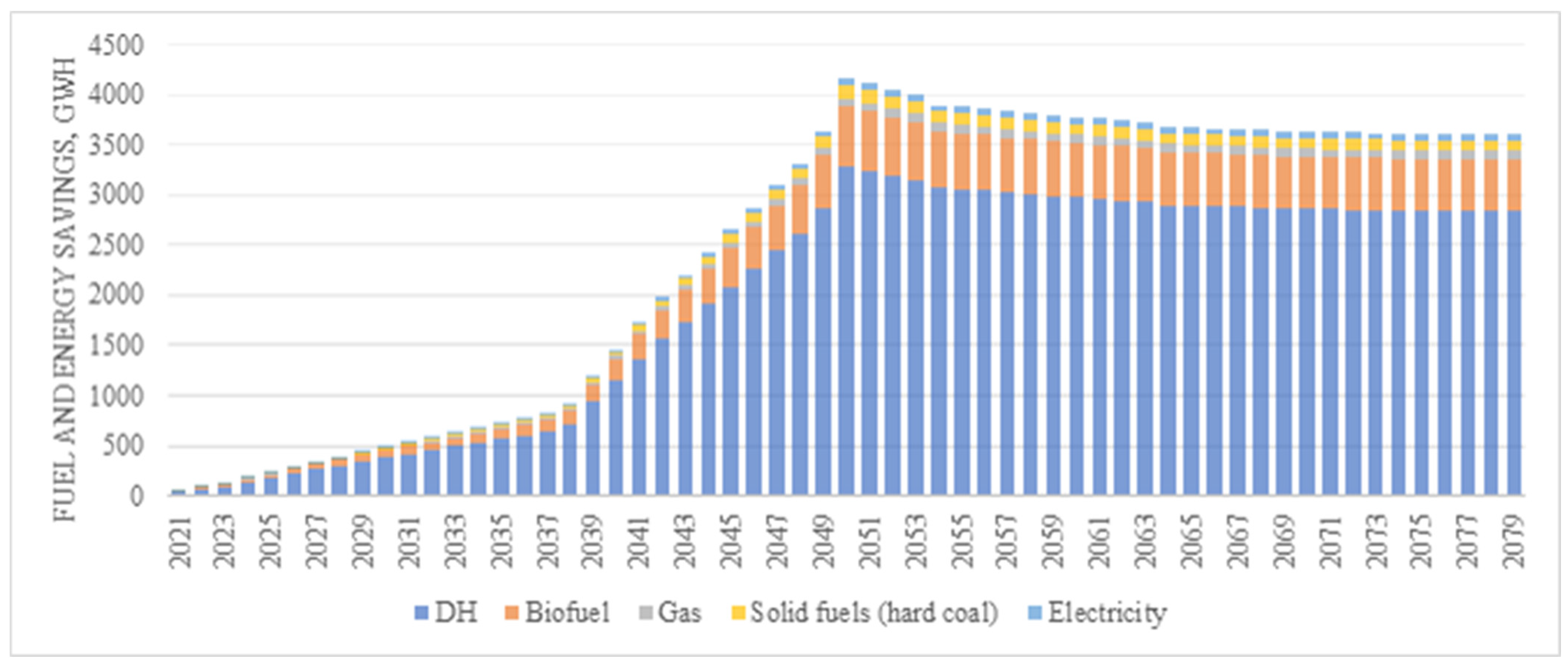
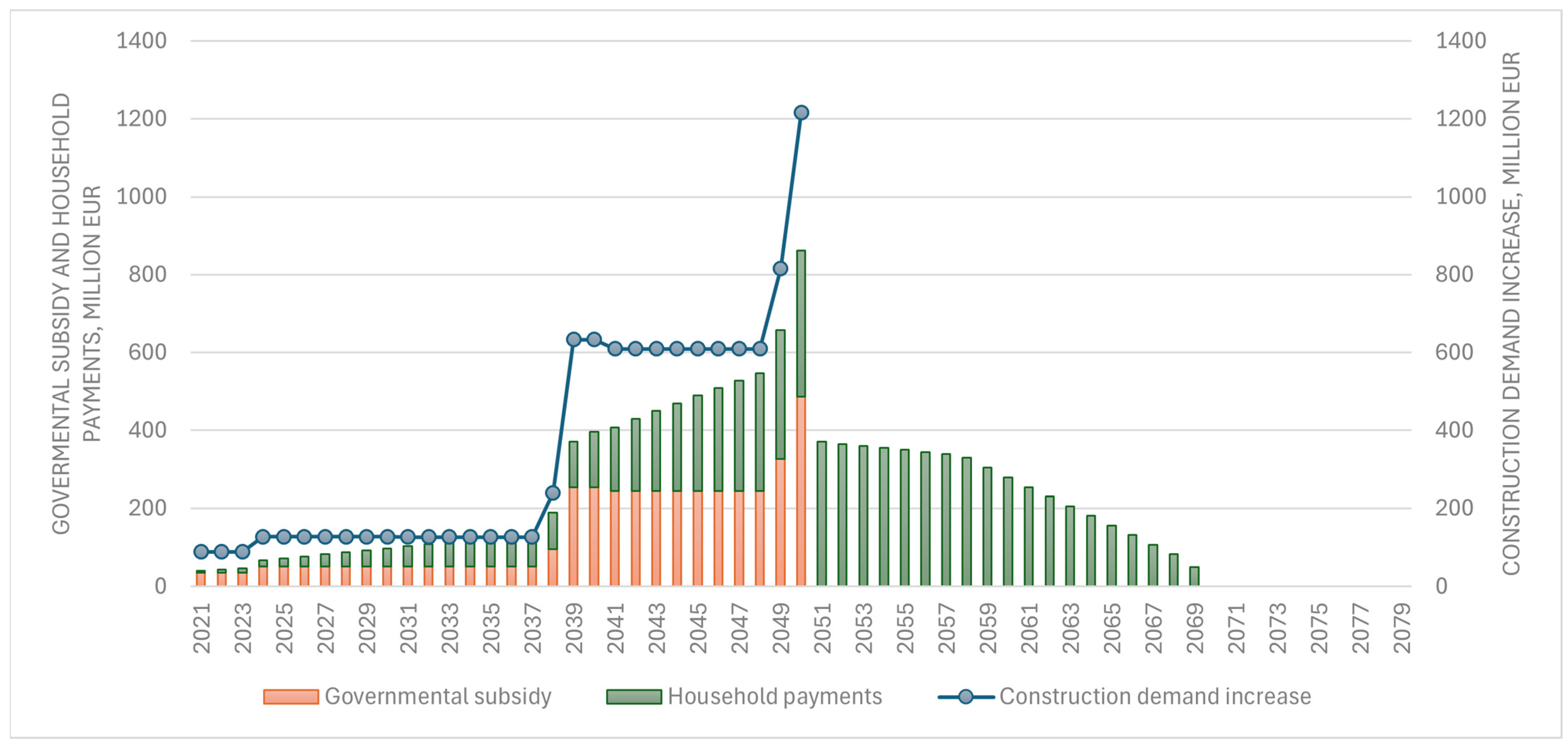
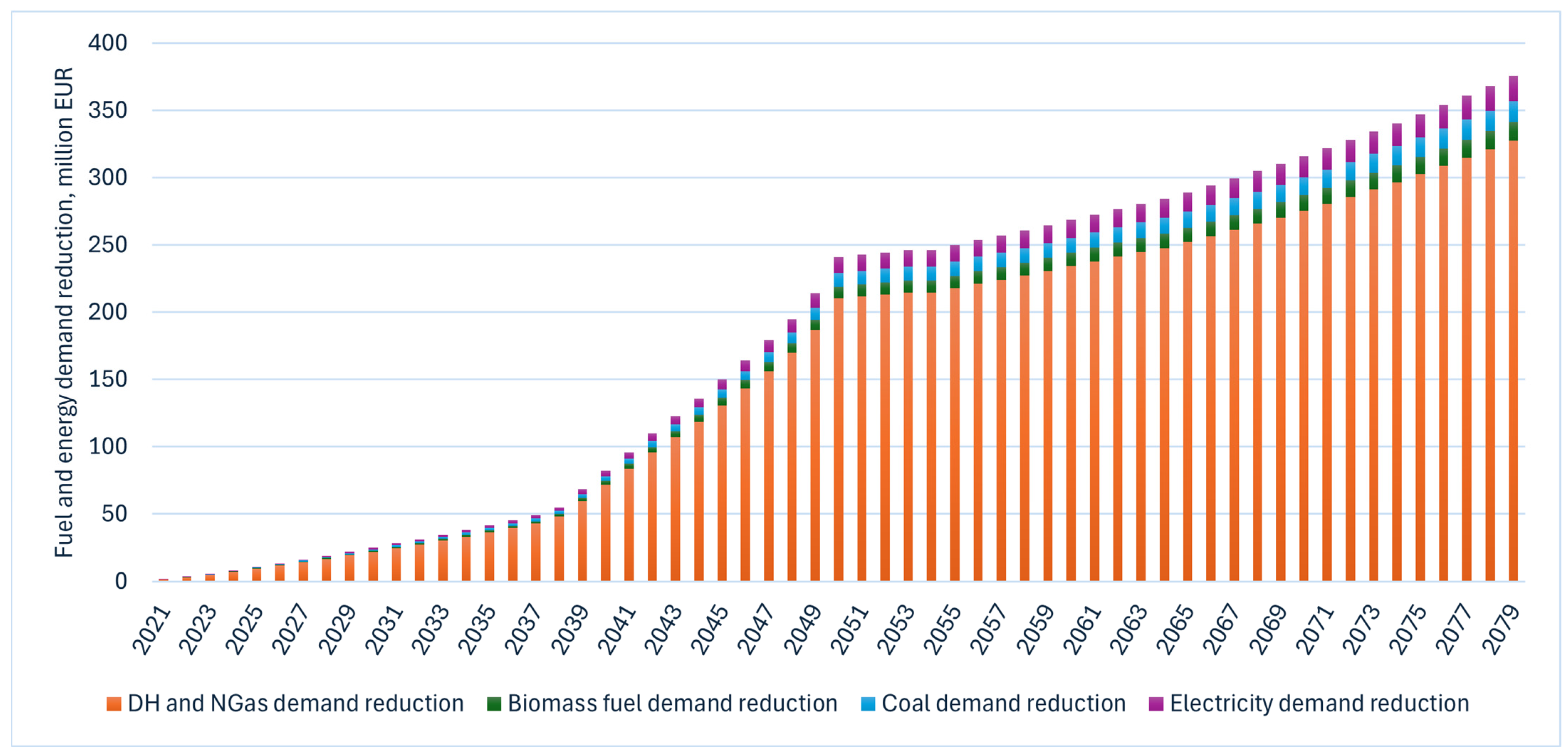
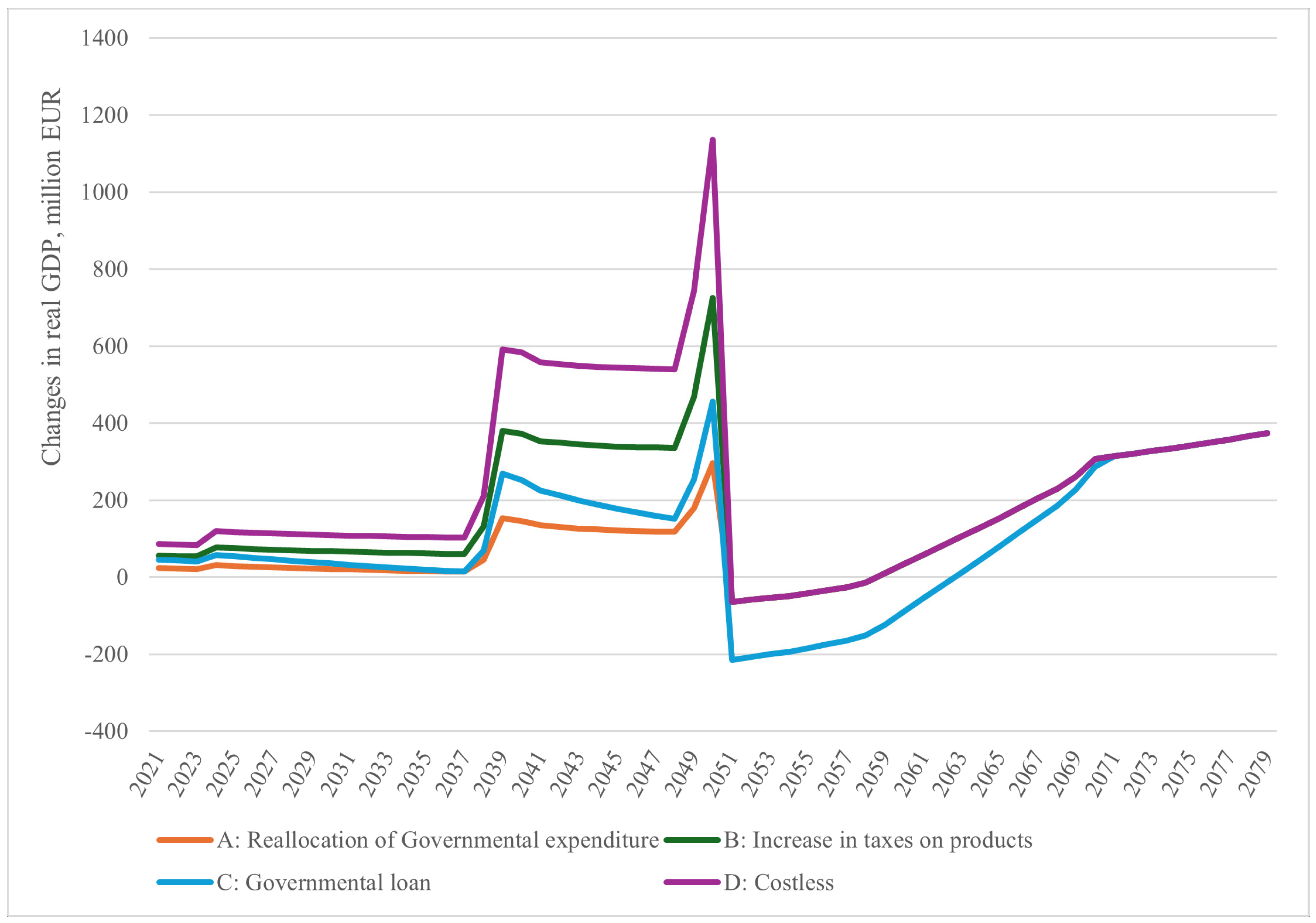

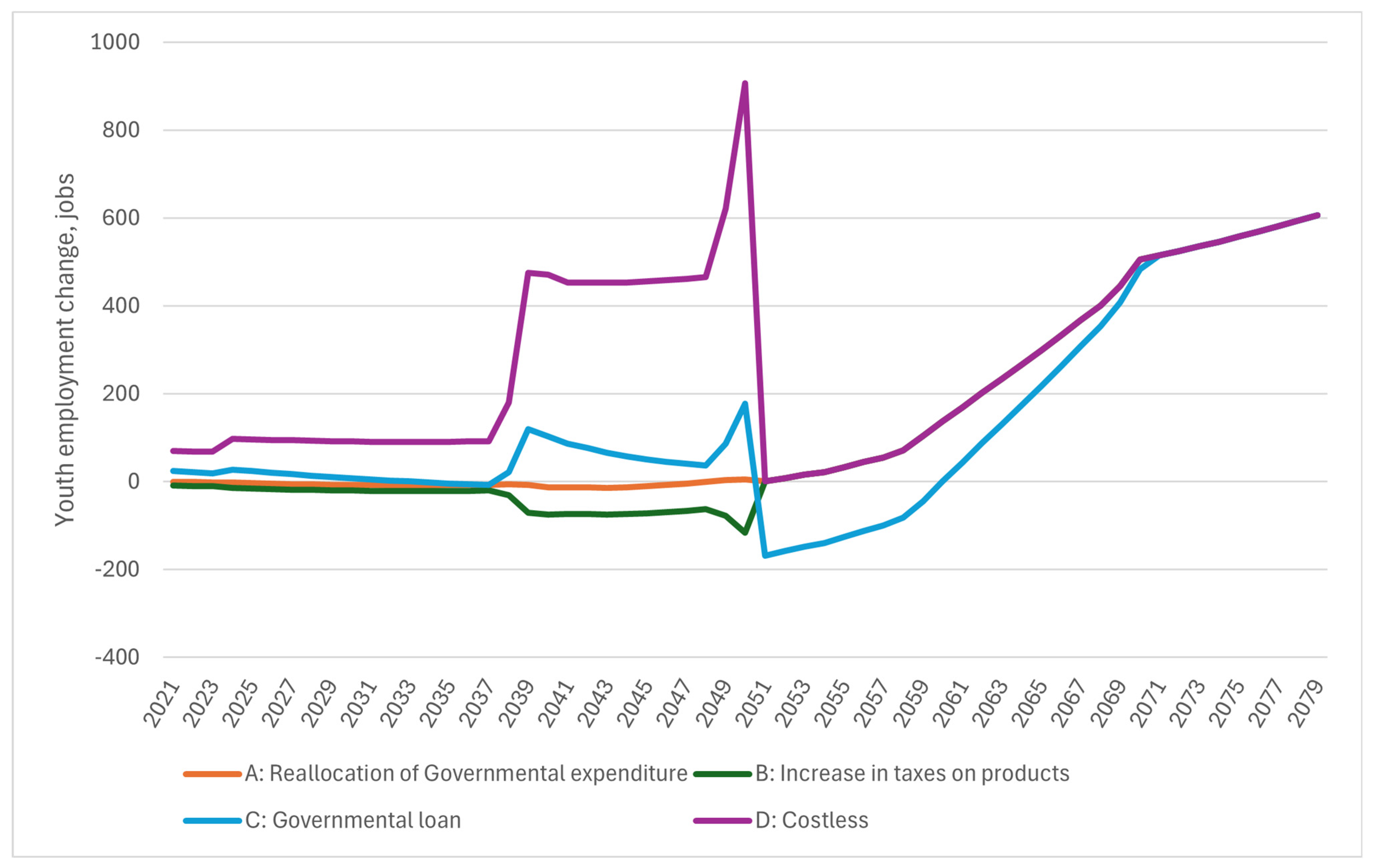
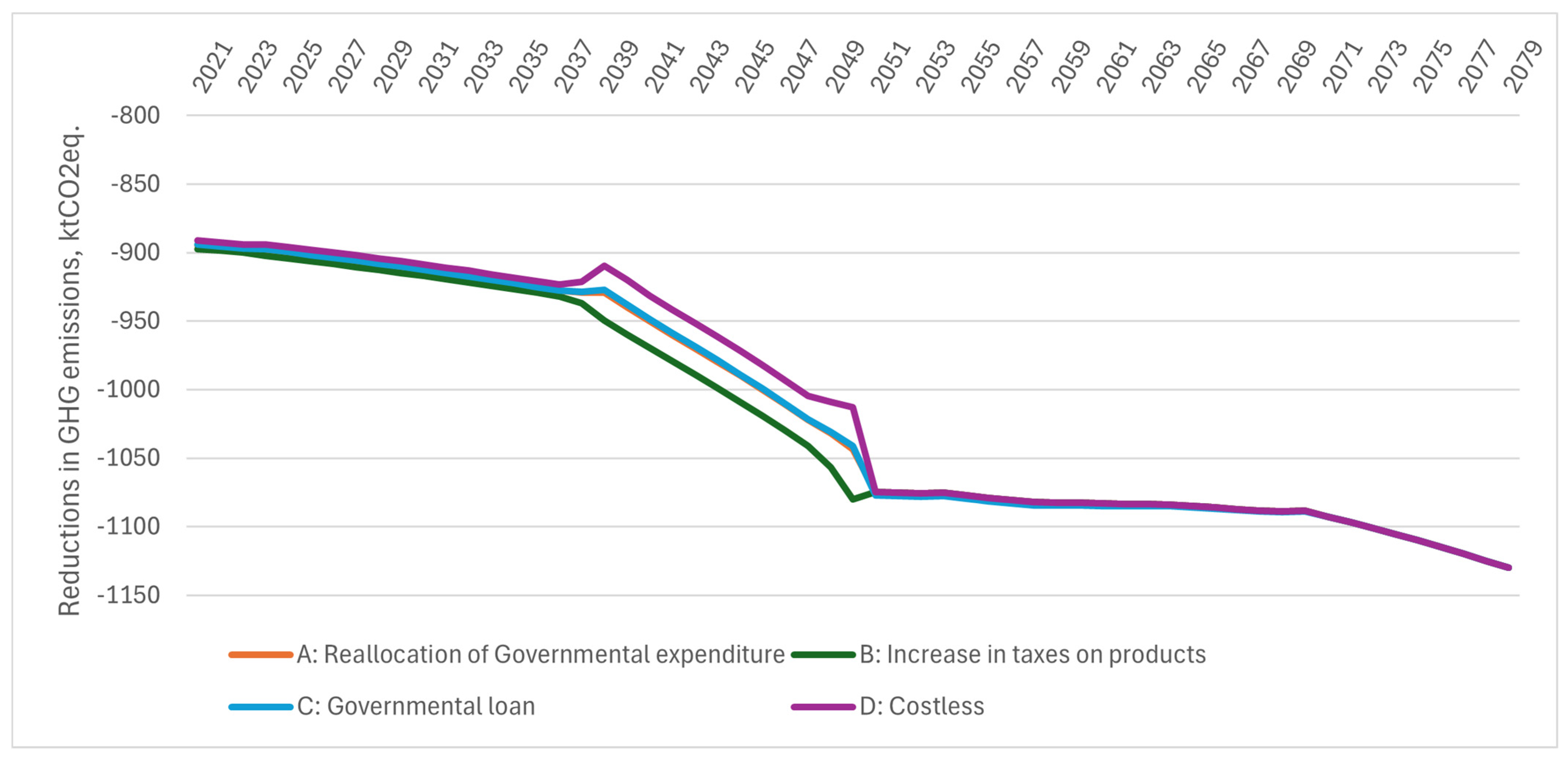
| Indicators | <1000 m2 | 1000–5000 m2 | >5000 m2 | Total |
|---|---|---|---|---|
| Primary fuel and energy savings from D class and lower to C, kWh/m2/year | 143 | 112 | 88 | |
| Number of multi-apartment buildings of class from D and lower, thousand units | 18.30 | 11.44 | 1.39 | 31.14 |
| Total area of multi-apartment buildings of class from D and lower, million m2 | 6.63 | 26.85 | 8.75 | 42.24 |
| Investment, EUR/m2 | 323 | 249 | 186 |
| Author (Year) | Country | Period of Analysis | Method | Level of Energy Efficiency Implementation | Results |
|---|---|---|---|---|---|
| Our study | Lithuania | 2021–2079 | CleanProdLT CGE model | Multi-apartment buildings | GDPs 0.23–0.48% a year Employment 0.11–0.32% a year Youth employment 0.15–0.33% a year GHG emissions −0.05% a year |
| Figus et al. [2] | United Kingdom (UK) | _ | UK-ENVI CGE model | Residential | GDPs 0.03–0.16% CPI 0.21–0.32% Employment 0.05–0.13% |
| Choi et al. [4] | Hamilton County | _ | IMPLAN | Residential heating | 6% of heating energy reduction Attic insulation: 47 jobs; 8.8 million USD economic output Furnace upgrades 57 jobs; 9.7 million USD economic output |
| Celani de Macedo et al. [3] | North Macedonia | - | IO | Industry | Net employment 43–897 jobs a year Value added −206 to 386 million MKD |
| Mirasgedis et al. [41] | Greek | IO analysis and the adjusted earnings gain approach | Buildings by energy efficiency measures | Replacement of old diesel boilers 24 full-time equivalent (FTE) jobs per EUR 1 million investment Insulation of external walls and roofs 21.1 FTE jobs Installation of double or triple-glazed windows 13.8 FTE jobs | |
| Bataille and Melton [6] | Canada | 2002–2012 | Regional General Equilibrium Energy Models | Country (region) | Energy expenditure −0.6% a year GDPs 0.19% a year (0.55% in oil and gas sectors; −(0.5–1.2) % in refining, natural gas, and hydroelectricity sectors) Employment 2.5% a year Household welfare 1.5% a year |
| Pollitt et al. [42] | EU28 | Up to 2030 | E3ME | Energy efficiency target is increased from 27% to 30–40%: EU and MS levels | GDPs 0.4–4.1% Employment 0.2–2.1% Health-related cost savings of 28.3–77.0 billion EUR GHG emissions reduced by 40.7–47.2% from 1990 level |
| Li et al. [43] | BRICS countries | 1990 to 2020 | CS-ARDL approach | Regional | 1% increase in energy efficiency could lead to an increase in economic growth of about 0.260 units in the short term and 0.319 units in the long term |
| Popescu et al. [44] | Romania | Survey | Old residential buildings | Thermal retrofitting increased their price by 2–3%, and 60% of investment in thermal retrofitting could be recovered during property transactions. | |
| Phadkantha and Tansuchat [45] | Thailand | 1990–2019 | Markov Switching ADRL model | Country level | Energy efficiency, economic growth, and renewable energy consumption nonlinearly impact carbon emissions. |
| Liu et al. [46] | Gävleborg region (Sweden) | By 2050 | Two simulation tools BV2 2010 and IDA ICE 4.0 Life Cycle Cost | Multi-apartment buildings | 43% primary energy reduction and 48% CO2 emissions reduction |
Disclaimer/Publisher’s Note: The statements, opinions and data contained in all publications are solely those of the individual author(s) and contributor(s) and not of MDPI and/or the editor(s). MDPI and/or the editor(s) disclaim responsibility for any injury to people or property resulting from any ideas, methods, instructions or products referred to in the content. |
© 2025 by the authors. Licensee MDPI, Basel, Switzerland. This article is an open access article distributed under the terms and conditions of the Creative Commons Attribution (CC BY) license (https://creativecommons.org/licenses/by/4.0/).
Share and Cite
Balsiūnaitė, R.; Bobinaitė, V.; Konstantinavičiūtė, I.; Lekavičius, V. Assessment of Socio-Economic and Environmental Impacts of Energy Efficiency Improvements in Multi-Apartment Buildings: Case Study of Lithuania. Sustainability 2025, 17, 957. https://doi.org/10.3390/su17030957
Balsiūnaitė R, Bobinaitė V, Konstantinavičiūtė I, Lekavičius V. Assessment of Socio-Economic and Environmental Impacts of Energy Efficiency Improvements in Multi-Apartment Buildings: Case Study of Lithuania. Sustainability. 2025; 17(3):957. https://doi.org/10.3390/su17030957
Chicago/Turabian StyleBalsiūnaitė, Rimantė, Viktorija Bobinaitė, Inga Konstantinavičiūtė, and Vidas Lekavičius. 2025. "Assessment of Socio-Economic and Environmental Impacts of Energy Efficiency Improvements in Multi-Apartment Buildings: Case Study of Lithuania" Sustainability 17, no. 3: 957. https://doi.org/10.3390/su17030957
APA StyleBalsiūnaitė, R., Bobinaitė, V., Konstantinavičiūtė, I., & Lekavičius, V. (2025). Assessment of Socio-Economic and Environmental Impacts of Energy Efficiency Improvements in Multi-Apartment Buildings: Case Study of Lithuania. Sustainability, 17(3), 957. https://doi.org/10.3390/su17030957







